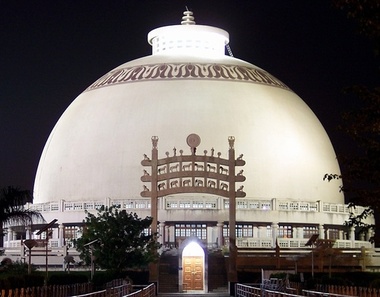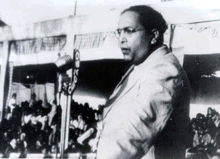Deekshabhoomi is a sacred monument of Buddhism in Nagpur the City of Oranges. Deekshabhoomi is a place where Dr.Baba Saheb Ambedkar converted into Buddhism and so did his thousands of followers. This conversion of religion took place on October 14th 1956. In the present scenario thousands of people come to Deekshabhoomi and convert into Buddhism.
Deekshabhoomi is situated in Nagpur, Maharashtra, India. Nagpur is the largest city in the state of Maharashtra and is also very famous for “Zero Milestone”. The centre is regarded as the pilgrimage center of Buddhism in India. Thousands of pilgrims visit Deekshabhoomi every year on the occasion of Ashok Vijaya Dashmi and on 14th October. Pilgrims from across the world come and visit Deekshabhoomi.
Deekshabhoomi is the place where not only BUDDHIST but all the people who believe in himself and the way of BUDDHA come together to pray for peace.
It is the place where a step was taken by Dr. Ambedkar against the ugly and hateful religious activites of Hindues or so called Savarnas.
It is situated in the heart of the NAGPUR city and off course heart of INDIA

Deeksha literally means acceptance of religion. Deeksha is to Buddhism as Baptism is to Christanity. Bhoomi means land. So, literally Deekshabhoomi means the land where people get converted to Buddhism. Deekshabhoomi is one of the two places of great importance in the life of Dr. Ambedkar, another being Chaityabhoomi at Mumbai. Deekshabhoomi is famous for its architectural beauty and historical importance. It is also one of the main centers of tourism in India. Deekshabhoomi is a sacred monument of Buddhism at the place where Dr. Babasaheb Ambedkar was converted to Buddhism along with thousands of his followers on October 14, 1956 Dr. Ambedkar"s conversion to Buddhism is still a guidance for the masses in India
Dhamma Chakra Stupa, aka Diksha Bhumi, is an important religious Buddhist monument located at Nagpur. It is at this place in 1956 Dr B R Ambedkar initiated the conversion of thousands of Dalit people to Buddhism. This day is celebrated as Ashok Vijaya Dashmi and on this day thousands of followers of Dr Ambedkar and Buddism join this place to offer floral tributes.
 History
History Dr. Ambedkar had already declared in 1935 that although he was born as a Hindu he would not die as one. After this declaration, he extensively studied the doctrines of all the major religions to choose Buddhism for him and his followers.
He selected Nagpur for his conversion ceremony, as he explained in his speech at that occasion, because Nagpur was the homeland of Nag people who embraced
Buddhism and supported it with great efforts in its early period. A ground near Ramdaspeth area in Nagpur was selected for the ceremony. On October 14, 1956, Dr. Ambedkar and his wife Mrs.Savita Ambedkar took oath of Three Jewels and Five Precepts from Mahasthavir Chandramani. Dr. Ambedkar, then, gave the oath of Three Jewels, five precepts, and 22 Vows to his thousands of followers.
Dr. Ambedkar died on December 6, 1956, just one and a half months after this ceremony. After his death Dr. Ambedkar Smarak Samiti was organized for the management of Deekshabhoomi. The committee decided to build a Stupa at the place as a monument of that ceremony and a mass conversion of people to Buddhism.
ArchitectureHistory of makingThe stupa of the sacred Deekshabhoomi was designed by famous architect Sheo Dan Mal[8]. Construction of the stupa started in July 1978, but it took a long time to finish. Sagar Enterprise of Mumbai, (Mr. H. C. Vakharia and Mr. Sandip Vakharia,) has completed structural work. The stupa was opened for the people on December 18, 2001 after a formal inaugration by the then President of India Dr. K. R. Narayanan
StupaDesign of the stupa at Deekshabhoomi is based upon the architecture of the world famous stupa of Sanchi. But unlike the stupa of Sanchi, Deekshabhoomi stupa is completely hollow from inside. It is the largest hollow stupa among all Buddhist
stupas in the world.[citation needed] At the ground floor, there is a 211 x 211 feet large square hall. At the centre of this hall, an idol of Buddha is placed. This idol was donated to Deekshabhoomi by Thai students learning in the university of Nagpur. There is also a library and a photo exhibition of the events in the lives of Gautama Buddha and Dr. Ambedkar.
Above the hall, there is a hollow dome. This dome is surrounded by a veranda. On all the four directions of the dome, fountains are there. Above the dome, there is a small slab and a little decorative umbrella. A high quality marble from Dholpur, Rajasthan is used for the flooring of the stupa. The stupa has doors on four directions. The doors open in large arcs, which are decorated with Ashok Chakras, and statues of horses, elephants, and lions, which gives an ancient look.
Around the stupa, there is a garden which is maintained by Nagpur Improvement Trust. Statues of Dr. Ambedkar and idols Gautama Buddha are situated in front of the stupa.
Vihar and the Bodhi TreeIn front of the stupa, on the right hand side, there is a Buddha Vihara with a bronze idol of lord Buddha. Facilities are also made there for the bhikkhus to live. Besides the Vihara, there is the Bodhi Tree, which is a sacred fig tree. This Bodhi Tree was planted at Deekshabhoomi from three branches of the Bodhi Tree at Anuradhapuram in Srilanka. Bhadant Anand Kausalyayan had brought these branches from Srilanka as the memoir of Buddhas enlightenment
TourismDeekshabhoomi is a prominent place of tourism for home and foreign tourists. Every year, thousands of tourists visit Deekshavhoomi, specially on the anniversary of the conversion ceremony.Foreign tourists come mainly from the Buddhist countries such as Japan and Thailand